💡Curious About the Future Leaders in Science and Technology?
For more than 50 years, the Industry University Cooperative Research Centers (IUCRC) have been generating leading-edge science and engineering research. In recent years, Centers have been busy advancing healthcare wearables, producing metal with lasers, improving concrete, or leading organic pesticide classification. Centers continue to push the bounds of science and technology across engineering, computer science, and geological science and engineering fields.
Overall, we found among the 80 Centers that:
- The number of active researchers working on IUCRC projects has never been higher.
- Total Center research publications and publications with members have increased. Since 2016, IUCRCs have generated about 70 patent applications per year, with 30 patents granted per year.
- Faculty are satisfied with the IUCRC Program, and benefit most by supporting their students and from the Center’s research accomplishments.
Centers Conduct Leading Early-Stage Research to Develop the Technologies of the Future
In FY2022 alone, the 80 IUCRC Centers generated:
- 1,288 peer-reviewer publications, Including 295 that were co-authored with Industry Advisory Board (IAB) members
- 75 patent applications, 28 patents granted, and much more.
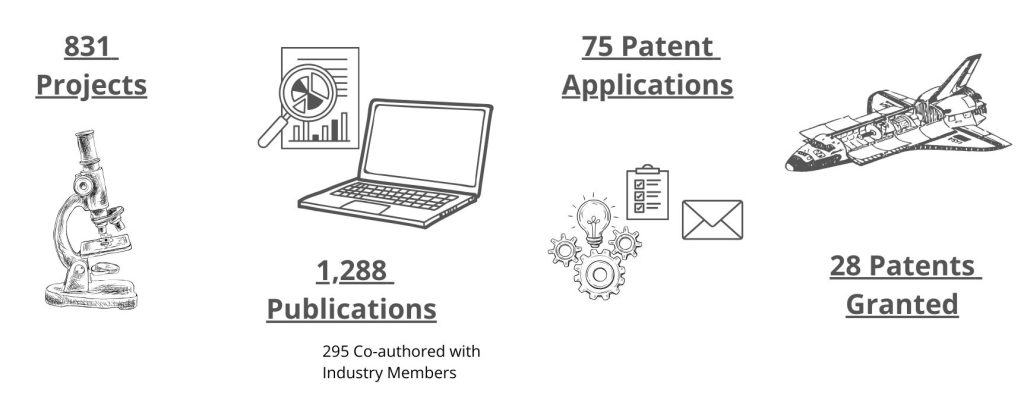
Please continue to learn more below!
Background
We discussed IUCRC’s contributions to the United States science and technology workforce in our Workforce Development page, and this post will focus on how IUCRC conducts high-impact research (Goal #1) and enhances U.S. leadership in technology development (Goal #2). As written in the current IUCRC program solicitation:
The IUCRC program catalyzes breakthrough pre-competitive research by enabling close and sustained engagement between industry innovators, world-class academic teams, and government agencies.
IUCRCs help industry partners and government agencies connect directly and efficiently with university researchers to achieve three primary objectives:
NSF 20-570: Industry-University Cooperative Research Centers Program (IUCRC)
- Conduct high-impact research to meet shared and critical industrial needs in companies of all sizes;
- Enhance U.S. global leadership in driving innovative technology development, and
- Identify, mentor and develop a diverse, highly skilled science and engineering workforce.
Program Solicitation
What Research Do Centers Conduct?
Research Projects
Centers conduct pre-competitive research through the pipeline of initial development. To do so, Centers carry out research projects based on the feedback of their IAB. These projects will be the focus of Center researchers and students for the academic year. Over time, Centers and their IAB Members collaborate to create a research roadmap, which NSF describes in the IUCRC program solicitation as “a portfolio of proposed innovative projects addressing significant industry challenges.”
A Center project is research that is both:
- shared with all Center’s members, AND
- carried out by Center-affiliated researchers.
With over 800 active projects last year, the examples are manifold.
Scientific Outputs
Publications
As Center personnel produce learnings from their research projects, they can publish their research in peer-reviewed journals. In FY2022 almost one in four publications were co-authored with industry members.
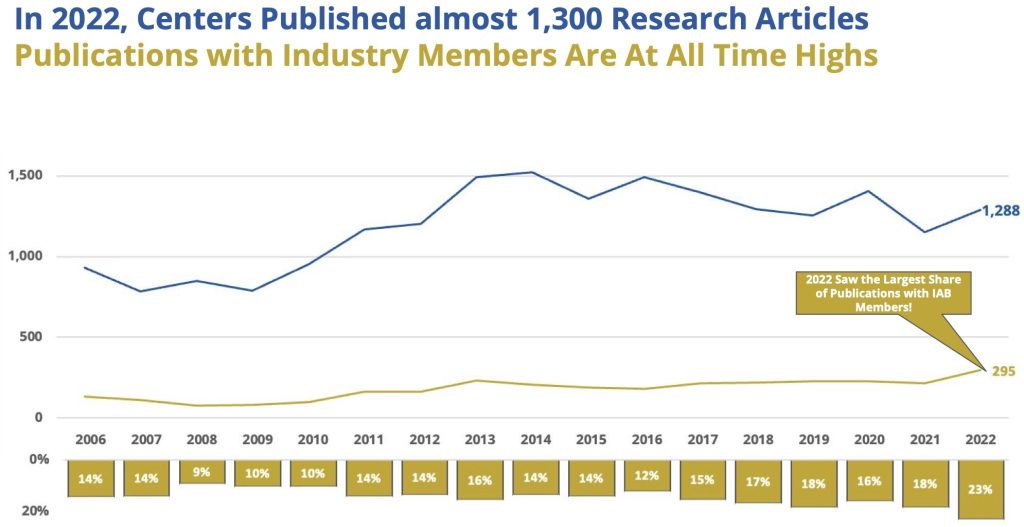
Intellectual Property
As Research develops, Centers research projects become commercializable via multiple paths.
- Invention Disclosures: While all Center research must be shared amongst all members, Centers can disclose those innovations to other companies as well. Invention Disclosures summarize the technology, provide potential applications, and other background information.
- Patent Applications: Novel innovations that may benefit from legal protections will go through the patent application process with the U.S. Patent and Trademark Office (USPTO).
- Patents Granted: When the USPTO grants a patent, the investors receive, “a property right granted by the government of the United States of America to an inventor to exclude others from making, using, offering for sale, or selling the invention throughout the United States or importing the invention into the United States for a limited time in exchange for public disclosure of the invention when the patent is granted.”US Patent and Trademark Office
- Software Copyrights: Similar to patents, but focused on computer-based programming, preventing others from copying or using their innovation without permission.
- Licensing Agreements: Inventors may allow companies to utilize their invention in exchange for royalties.
- Inventions Producing Royalties: Commercializable inventions being sold for use or incorporated in the market.
- Startup Companies Formed: In addition to existing incumbent companies utilizing a technology, new startup companies can form to identify whether the invention is commercializable by raising capital, prototyping, and eventually selling to customers.
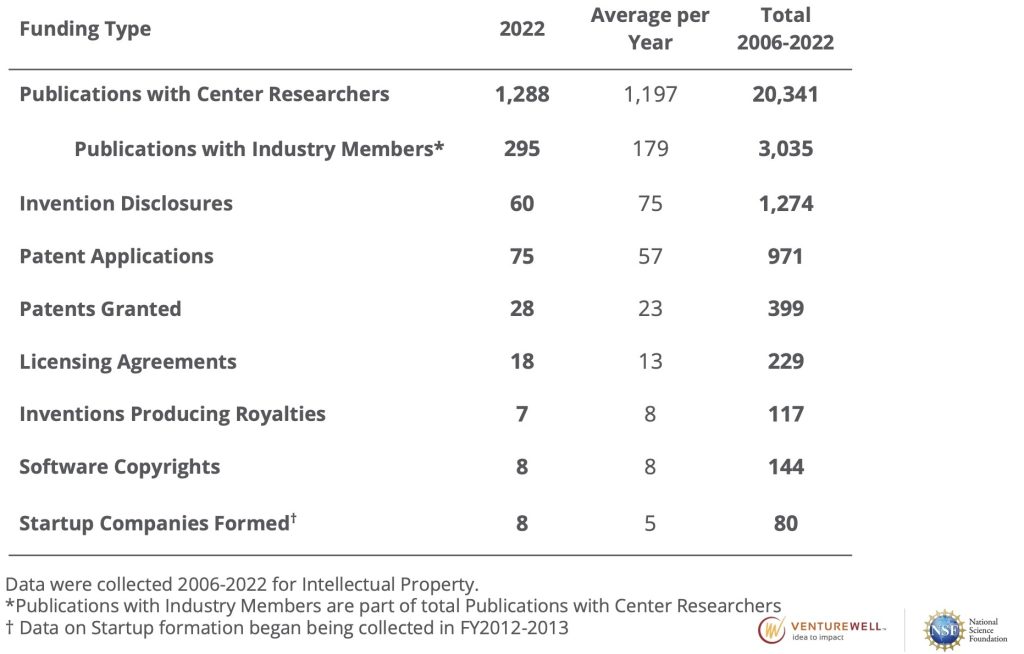
In 2022, numerous Centers generated a high number of research outputs. For example, AMBIC cited 22 active projects in the year, while CEHMS indicated their Center’s researchers had 54 peer-reviewed publications. The Center for Advanced Knowledge Enablement cited eight invention disclosures, and 13 patent applications during the year.
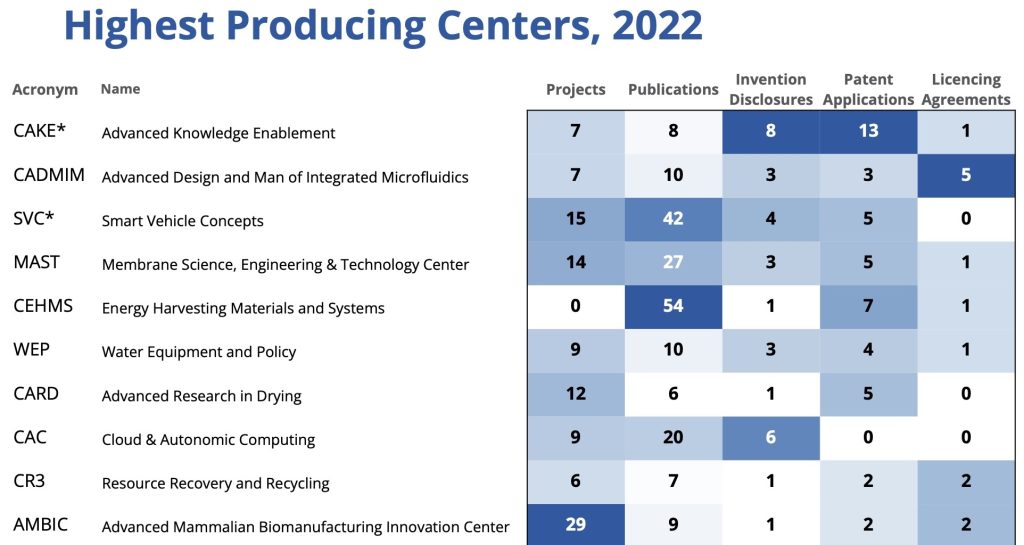
Watch to learn more:
Who Conducts Center Research?
IUCRC research stems from the 1,977 students, 1,615 researchers, and 189 administrative staff who work for their Centers. The publications, invention disclosures, and other markers of technological advancement are, of course, created by the researchers that together make IUCRC function.
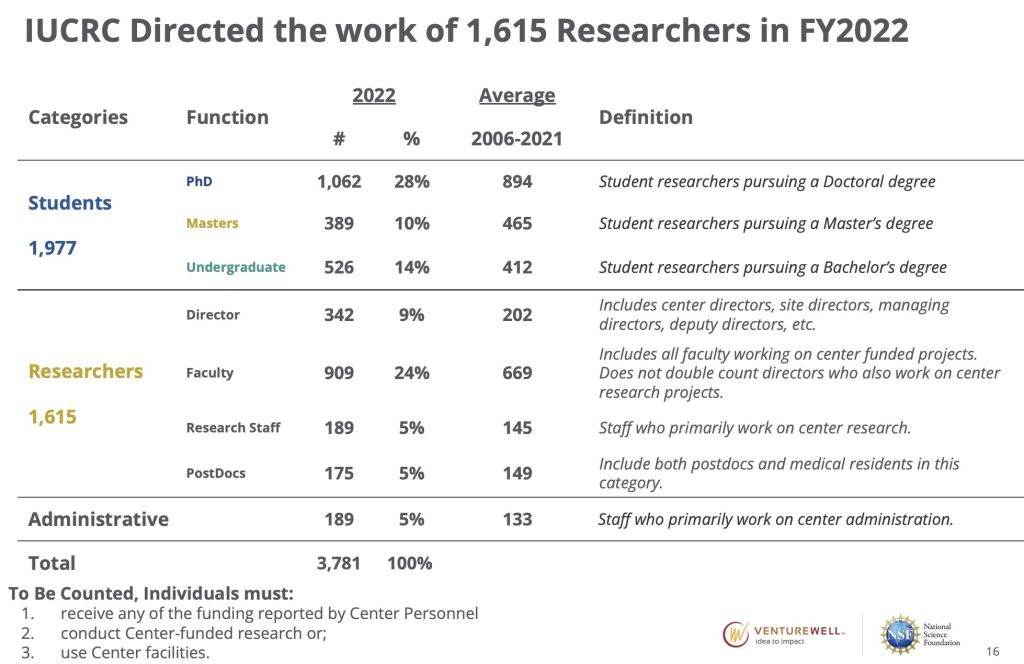
Since 2006, IUCRC has grown overall. Students have remained the largest category of active researchers in Centers, though IUCRC as a program remains below the peak year in 2016.
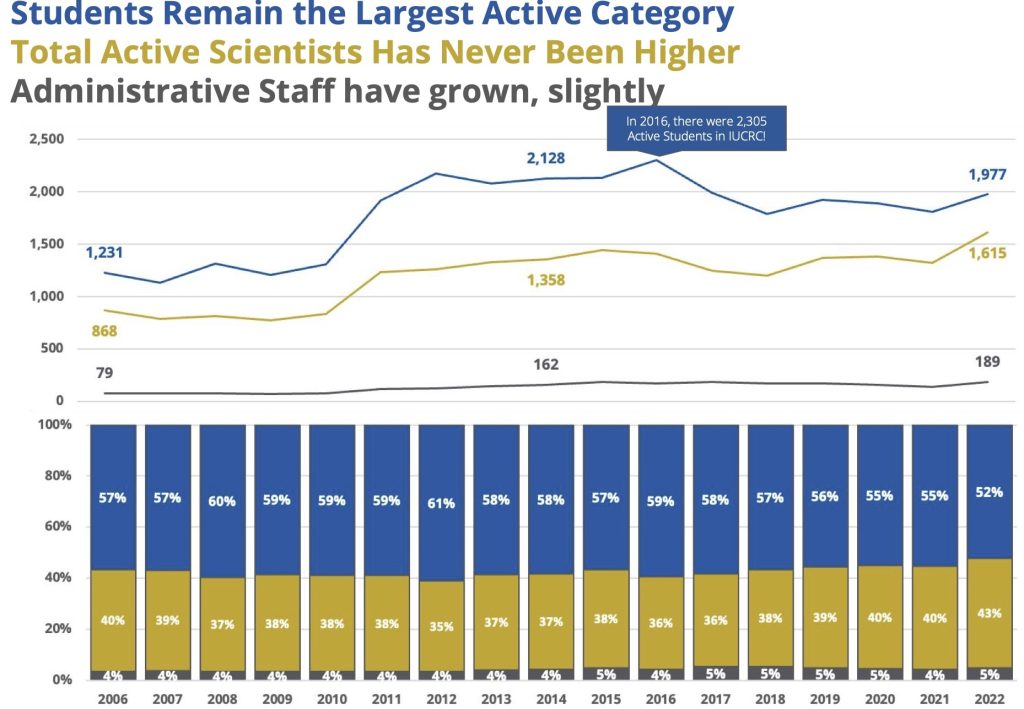
The number of Centers has also grown over this period, and by controlling for the number of Centers we see, students have decreased over since 2006.
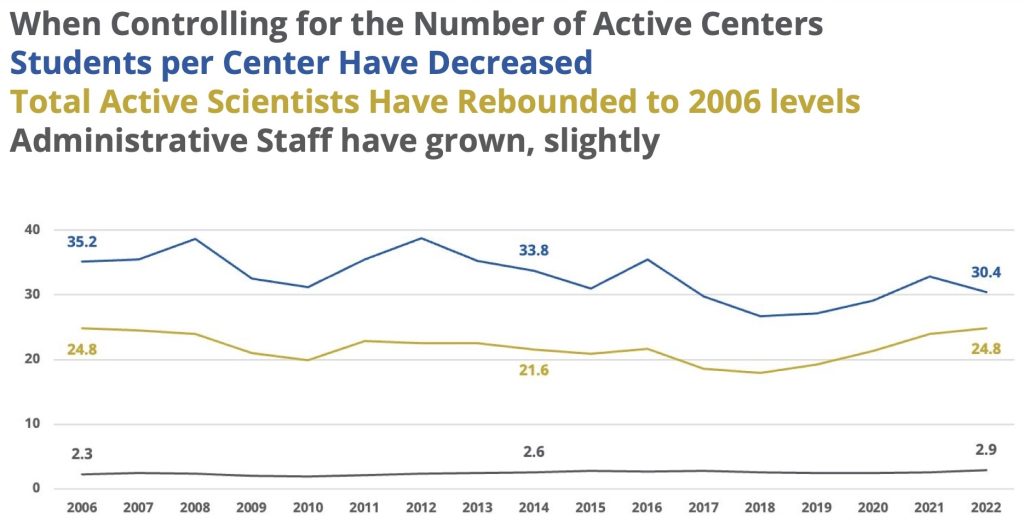
Of those Research Scientists, non-director faculty researchers have been the majority of research personnel and are at peak levels. The number of directors has also increased over this time, a reflection of both the growth in the number of Centers and sites per Center.

Watch to learn more:
What do Researchers Think of Their Experience?
Perhaps most importantly, Centers benefit when their faculty members offer their best ideas. Overall, approximately four in five respondents have consistently indicated they probably or definitely will submit their best ideas as research ideas for Center projects.
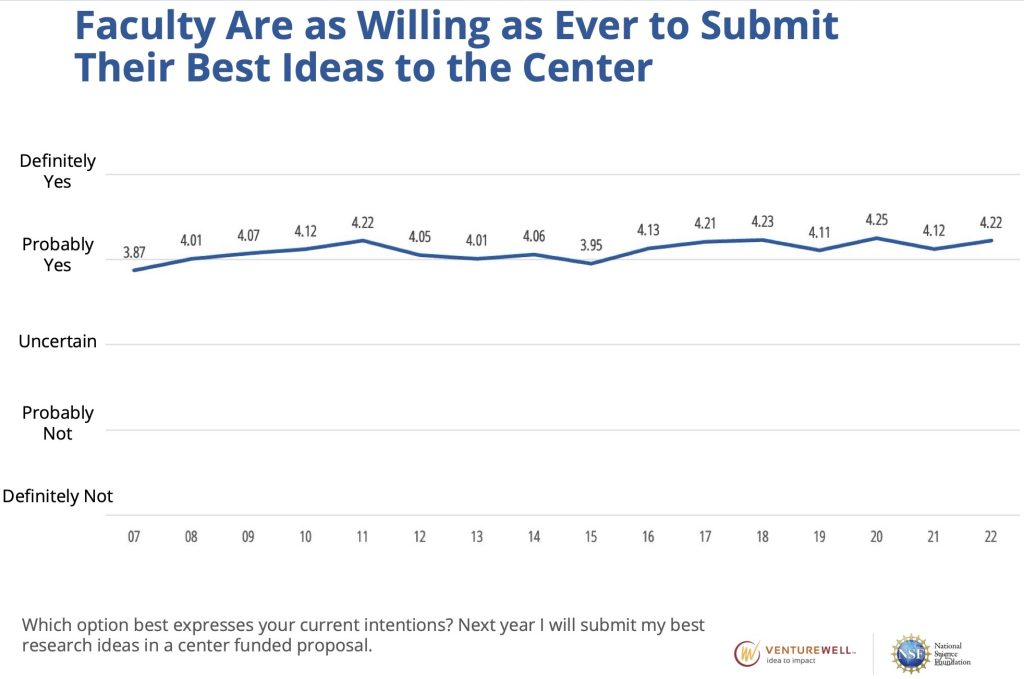
Researcher satisfaction has increased since 2006 regarding their Center’s research focus, research quality, and Center administration.
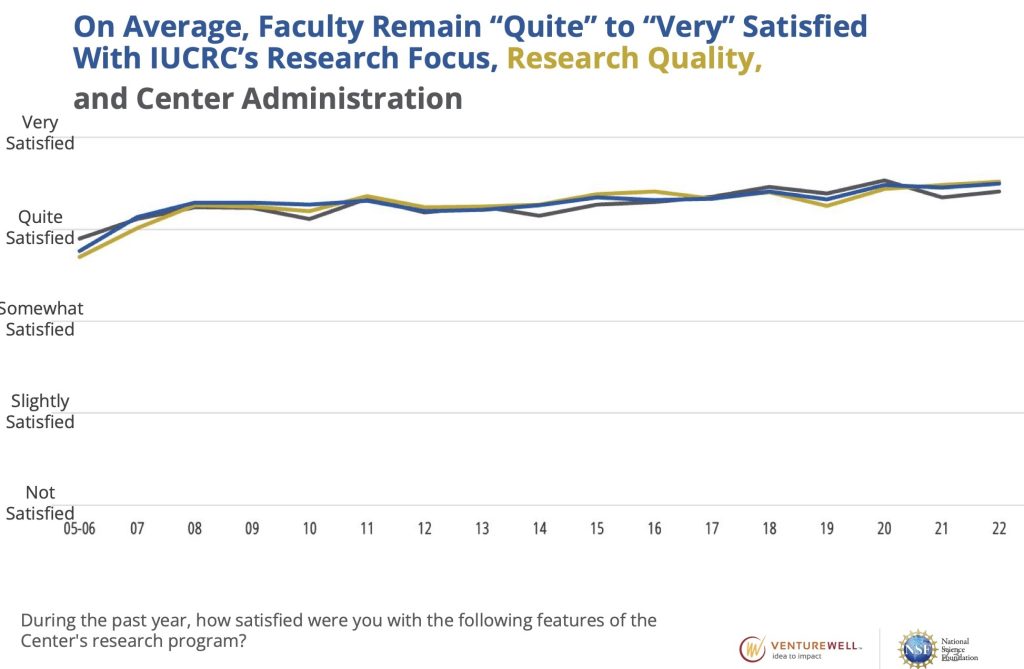
When asked about the most impactful aspect of their Center participation, researchers most often cited their sense of accomplishment from conducting research, the opportunities to conduct that research, and their ability to mentor and support students.

Researchers provided a number of areas of improvement for their Center. Notably, one in three respondents cited fundraising as a key need, while one in five recommended improvements in Center communications and their program planning.
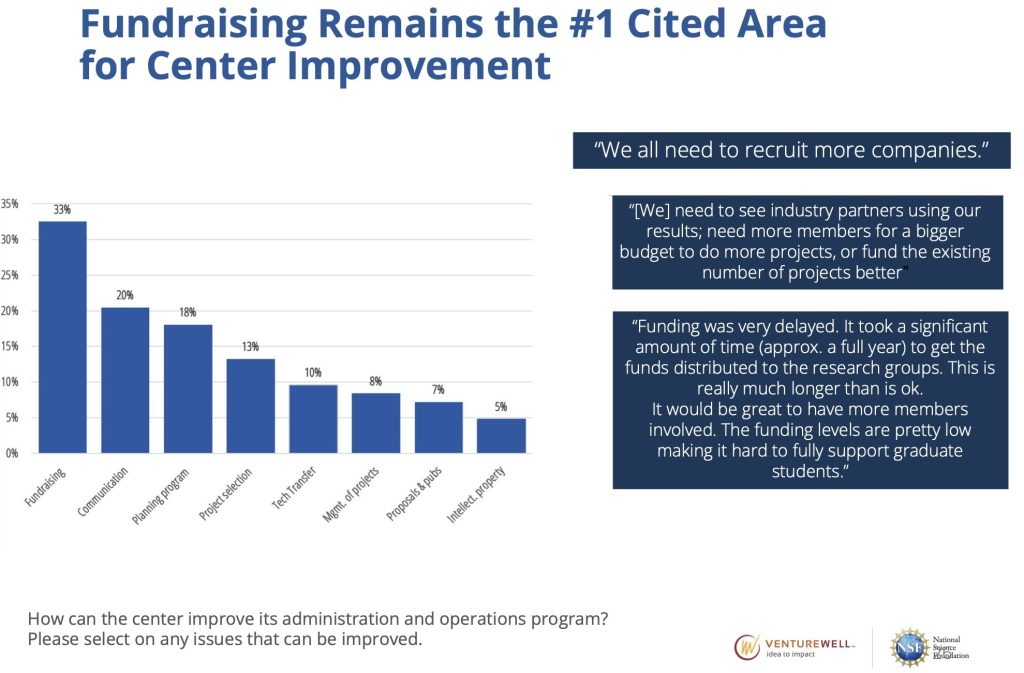
Watch to Learn More:
Want to Learn More?
Want to Learn More About the Research?
Every technology advancement is different and worth exploring! If you would like to know more about science and technology breakthroughs from IUCRC, please see the NSF website or you may browse those breakthroughs below. For less recent technologies, you can review the 2016 Compendium of Technology Breakthroughs.
